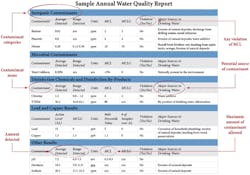Good drinking water quality is something that many of us take for granted. Because water quality can vary depending upon where you live, it’s important to know where your drinking water supply comes from and if it contains any impurities that could pose a health risk.
If you use a drinking water filter or similar product to treat your drinking water, you’re not alone. Nearly half of all Americans now use home water treatment products such as filters. However, many don’t consider specific contaminants when it comes to treating tap water.
Survey says
A recent NSF International survey of more than 2,000 Americans found that 44 percent have or use a home water filter or drinking water treatment system. However, most consumers (54 percent) are not buying water filters to remove specific contaminants and fewer than one in five people (17 percent) purchased a water filter after researching the contaminants in their home’s tap water.
Additionally, more than half of Americans who have a home water filter purchased the water treatment system for reasons unrelated to the quality of their tap water, citing the following as influencing their decision: The system came with the home (35 percent); it was recommended by family or friends (11 percent); or they received positive online reviews (8 percent).
What does this imply? Most consumers are not taking advantage of a key resource that can help them learn more about the quality of their tap water: Consumer confidence reports (CCRs). These free annual reports list the specific contaminants found in the local water supply. They can be the best resource when buying a water filter, yet NSF’s survey found that only 30 percent of Americans actually read and understand the information in the water quality reports. The others surveyed admitted to not reviewing their reports (26 percent), not knowing what the report is (18 percent) or reviewing the report but not understanding the implications of what they are reading (9 percent).
CCRs are mailed each July to households aside from those with private well water and provide a snapshot of water quality in a specific city or area. They list specific data on which contaminants were detected in the water, at what levels and how these levels compare to U.S. Environmental Protection Agency (EPA) or state drinking water regulations.
CCRs can help identify what contaminants are present in the local water supply and how these substances may affect our health or the aesthetic quality (taste or odor) of water. People living in apartments or condominiums may not receive a copy directly but can access this information on their community's website or by calling their local water department.
In most U.S. public water supplies, contaminants do not exceed EPA public health limits and are not present at levels that are known to cause health issues. While some contaminants are naturally occurring, like radon, radium and arsenic, people, animals and industry can also add contaminants such as microorganisms, pesticides and nitrates to water supplies.
Once consumers know which contaminants are in the water, and at what levels, the next steps are deciding which specific contaminants they want to reduce and determining which type of water filter is most effective for the task.
Choosing the right filter
No single filtration product can eliminate all potential contaminants. That’s why it’s important to choose a system with the technology that can treat your specific water needs, one that is tested and certified to reduce the contaminants of particular concern to you — whether based on the findings of the water quality report or on individual health concerns. The five most common treatment technologies and what contaminants they can potentially address include:
- Filters: Chemicals, some metals, parasites, sediment, taste and odor
- Cation exchange softeners: Hard water (some also barium and radium)
- Distillers: Heavy metals, minerals, non-volatile chemicals
- Reverse osmosis: Some metals, minerals, parasites; post-filter may also reduce some chemicals
- Ultraviolet disinfection: Bacteria and viruses.
In addition, help customers look for a system that is certified by an independent third-party testing organization. This provides assurance that the product effectively reduces contaminants as claimed by the manufacturer while meeting minimum standards for structural integrity, materials and labeling. To maintain the effectiveness of the system, it’s also important to change filter components regularly according to the manufacturer’s instructions.
This telephone survey (combined landline and cell phone) was conducted by ORC International on behalf of NSF International among a sample of 2,025 adults, 1,105 men and 1,010 women, 18 years of age and older, living in the continental United States. Calibration weighting was used to weight the sample and to reduce the potential for sample bias, ensuring that the results reflect the population. The survey was fielded over two consecutive weekends (June 20th-23rd and June 27th-30th, 2013) in order to attain a sample of 942 adults with water filters. Results have a margin of error of +/- 3 percent at the 95 percent confidence level.
Cheryl Luptowski is the home safety expert for NSF International, an independent public health and safety organization that certifies products and writes standards in the areas of drinking water, consumer products, dietary supplement safety and sustainability. NSF International led the development of the American National Standards for all materials and products that treat or come in contact with drinking water. In 1990, the U.S. EPA replaced its drinking water product advisory program with these NSF standards. Today, all major plumbing codes require certification to NSF standards for pipes and plumbing components in commercial and residential buildings.



